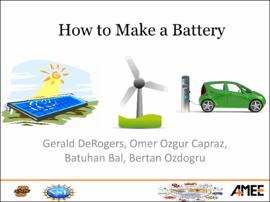| dc.contributor.advisor | Capraz, Omer Ozgur | |
| dc.contributor.author | DeRogers, Gerald | |
| dc.contributor.author | Bal, Batuhan | |
| dc.contributor.author | Ozdogru, Bertan | |
| dc.contributor.other | Oklahoma State University. Advanced Materials and Electrochemistry for Energy Laboratory | |
| dc.date.accessioned | 2021-09-28T01:09:21Z | |
| dc.date.available | 2021-09-28T01:09:21Z | |
| dc.date.issued | 2021-10-09 | |
| dc.identifier | oksd_OK-LSAMP_2021_derogers | |
| dc.identifier.citation | DeRogers, G., Capraz, O. O., Bal, B., & Ozdogru, B. (2021, October 9). How to make a battery. Presentation at the Oklahoma Louis Stokes Alliance for Minority Participation's 27th Annual Research Symposium, Stillwater, OK. | |
| dc.identifier.uri | https://hdl.handle.net/11244/330974 | |
| dc.description.abstract | Background: The steady increase in the consumption of fossil fuels in modern society has caused several serious environmental and human health issues. The burning of fossil fuels not only produces carbon dioxide emissions, which are contributing to global warming and poisoning the world’s oceans but also releases toxic air-borne pollutants into the atmosphere4,5. Most commercial batteries are currently being mass-produced to power personal electronics, store renewable energy, and more recently, power electric automobiles. I believe we can utilize them for even more, but to do that we must understand, deeply, how a battery works. | |
| dc.description.abstract | Research Objective: Learn the chemistry process of a battery, so I can test the concept of toxic diesel soot being recycled and used in a Na-ion battery to make more affordable batteries and create sustainable material sources by harvesting industrial waste as a valuable material for batteries. | |
| dc.description.abstract | Research Plan: Through this research, I will learn to manufacture Na-ion batteries as well as test them using cyclic voltammetry and galvanostatic cycling. The learning process involves the fabrication of composite electrodes, usage of glove boxes, assembly of coin battery cells, and executing electrochemical measurements. I will closely work with the graduate students in the group. The performance of the diesel soot anode will be tested at various scan rates and an electrolyte environments. | |
| dc.description.abstract | Expected Results: With the chemical knowledge behind the battery I can begin to see which technique provides the highest quality harvested ship soot carbon, there will be enormous opportunities to fabricate more affordable Na-ion batteries for grid-scale storage. Furthermore, with an established high-quality baseline the progress of sodium-ion battery research can only increase allowing earlier entrance into the commercial and industrial worlds. This ultimately results in a cheaper, more available energy source for the masses. | |
| dc.description.sponsorship | Oklahoma Louis Stokes Alliance for Minority Participation Program | |
| dc.description.sponsorship | National Science Foundation (U.S.) | |
| dc.format | application/pdf | |
| dc.language | en_US | |
| dc.publisher | Oklahoma State University | |
| dc.rights | In the Oklahoma State University Library's institutional repository this paper is made available through the open access principles and the terms of agreement/consent between the author(s) and the publisher. The permission policy on the use, reproduction or distribution of the article falls under fair use for educational, scholarship, and research purposes. Contact Digital Resources and Discovery Services at lib-dls@okstate.edu or 405-744-9161 for further information. | |
| dc.title | How to make a battery | |
| osu.filename | oksd_OK-LSAMP_2021_derogers.pdf | |
| dc.description.department | Chemical Engineering | |
| dc.type.genre | Presentation | |
| dc.type.material | Text | |
| dc.type.material | Image | |
| dc.subject.keywords | battery | |
